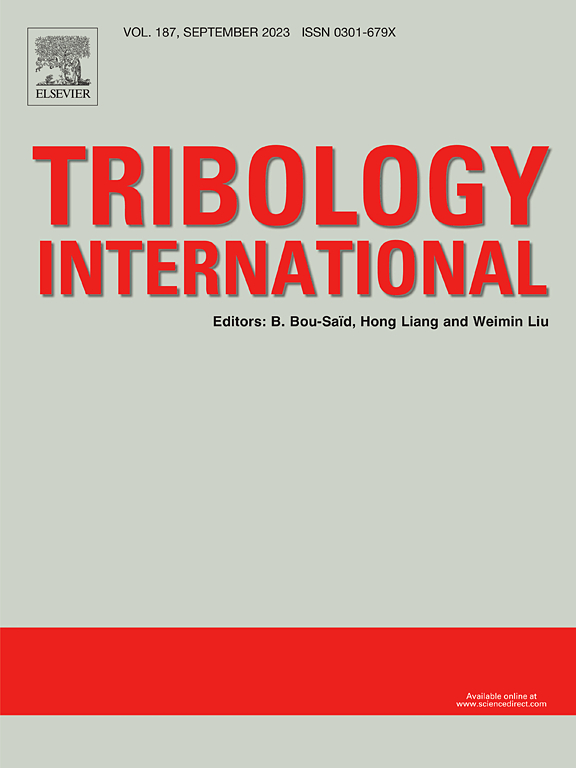石墨烯空位缺陷密度对极低温下ptfe基复合材料摩擦学性能的影响:来自反应分子动力学模拟的见解
IF 6.1
1区 工程技术
Q1 ENGINEERING, MECHANICAL
引用次数: 0
摘要
在极低温(80 K)条件下,利用反应力场分子动力学模拟研究了不同缺陷密度(DGr = 0 %,2 %,4 %,8 %)的石墨烯(Gr)填料对聚四氟乙烯(PTFE)基复合材料摩擦学性能的影响。结果表明:低缺陷密度Gr填料(DGr = 0 %,2 %,4 %)可使PTFE的摩擦力和摩擦系数降低约50 %,显著改善PTFE的润滑性能,有效抑制热积累,使温度降低约21 %。然而,当DGr达到8 %时,Gr填料的导热系数降低,导致温升2.29 %,摩擦性能恢复到纯PTFE的水平。此外,低缺陷密度Gr填料通过促进PTFE分子运动和减少界面机械混合进一步优化了摩擦性能。本文章由计算机程序翻译,如有差异,请以英文原文为准。
Graphene vacancy defect density effects on the tribological performance of PTFE-based composites at extreme low temperatures: Insights from reactive molecular dynamics simulations
This study investigates the effect of graphene (Gr) fillers with different defect densities (DGr = 0 %, 2 %, 4 %, 8 %) on the tribological properties of polytetrafluoroethylene (PTFE)-based composites under extremely low-temperature conditions (80 K) using reactive force field molecular dynamics simulations. The results show that low defect density Gr fillers (DGr = 0 %, 2 %, 4 %) significantly improve the lubrication performance of PTFE by reducing friction force and coefficient by approximately 50 %, and effectively suppress heat accumulation, lowering the temperature by about 21 %. However, when DGr reaches 8 %, the thermal conductivity of the Gr fillers decreases, leading to a temperature rise of 2.29 %, and the friction performance returns to the level of pure PTFE. Additionally, the low defect density Gr fillers further optimize the tribological performance by promoting PTFE molecular movement and reducing interface mechanical mixing.
求助全文
通过发布文献求助,成功后即可免费获取论文全文。
去求助
来源期刊

Tribology International
工程技术-工程:机械
CiteScore
10.10
自引率
16.10%
发文量
627
审稿时长
35 days
期刊介绍:
Tribology is the science of rubbing surfaces and contributes to every facet of our everyday life, from live cell friction to engine lubrication and seismology. As such tribology is truly multidisciplinary and this extraordinary breadth of scientific interest is reflected in the scope of Tribology International.
Tribology International seeks to publish original research papers of the highest scientific quality to provide an archival resource for scientists from all backgrounds. Written contributions are invited reporting experimental and modelling studies both in established areas of tribology and emerging fields. Scientific topics include the physics or chemistry of tribo-surfaces, bio-tribology, surface engineering and materials, contact mechanics, nano-tribology, lubricants and hydrodynamic lubrication.
 求助内容:
求助内容: 应助结果提醒方式:
应助结果提醒方式:


